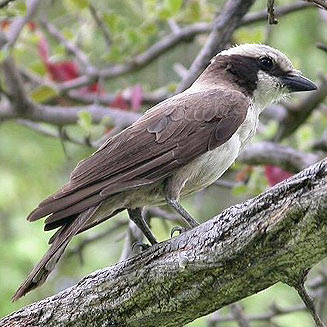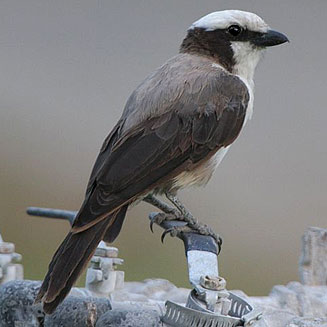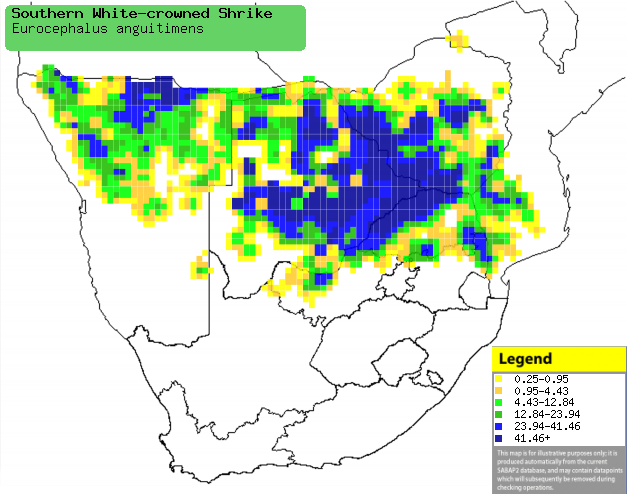|
Eurocephalus anguitimens
(Southern white-crowned shrike, White-crowned shrike)
Kremetartlaksman [Afrikaans]; Witkruinklauwier [Dutch];
Eurocéphale à couronne blanche [French]; Weißscheitelwürger [German];
Picanço-de-coroa-branca [Portuguese]
Life
> Eukaryotes >
Opisthokonta
> Metazoa (animals) >
Bilateria >
Deuterostomia > Chordata >
Craniata > Vertebrata (vertebrates) > Gnathostomata (jawed
vertebrates) > Teleostomi (teleost fish) > Osteichthyes (bony fish) > Class:
Sarcopterygii (lobe-finned
fish) > Stegocephalia (terrestrial
vertebrates) > Tetrapoda
(four-legged vertebrates) > Reptiliomorpha > Amniota >
Reptilia (reptiles) >
Romeriida > Diapsida > Archosauromorpha > Archosauria >
Dinosauria
(dinosaurs) > Saurischia > Theropoda (bipedal predatory dinosaurs) >
Coelurosauria > Maniraptora > Aves
(birds) >
Order: Passeriformes > Family: Laniidae
 |
 |
|
Southern white-crowned shrike, Etosha National
Park, Namibia.
[photo Toby Austin ©] |
Southern white-crowned shrike, Etosha National
Park, Namibia. [photo Trevor Hardaker ©] |
Distribution and habitat
Near-endemic to southern Africa, occurring from the North
West and Limpopo Provinces to south-Eastern Mozambique, Zimbabwe, Botswana and
northern Namibia, extending marginally into southern Angola. It generally
favours savanna woodland with sparse ground cover, as well as deciduous and
riverine woodland.
|
 |
|
Distribution of Southern white-crowned shrike in southern Africa,
based on statistical smoothing of the records from first SA Bird Atlas
Project (©
Animal Demography unit, University of
Cape Town; smoothing by Birgit Erni and Francesca Little). Colours range
from dark blue (most common) through to yellow (least common).
See here for the latest distribution
from the SABAP2. |
Food
It mainly eats insects, often perching in a prominent position, searching for a food item.
Once it spots something it dives to the ground and catches it. It also hunts at ground level
and often joins mixed-species flocks. The following food items haven recorded in its diet:
Breeding
- A facultative cooperative breeder, meaning that the alpha female and male
or assisted by about 1-4 helpers.
- The breeding pair as well as group members construct the nest, which is
a neat cup built of fine, shredded grass reinforced with spider web. It is
typically placed in the horizontal fork of a branch.
- Egg-laying season peaks from October-November.
- It lays 2-5 eggs, which in one observation where incubated mainly by the
alpha female for about 20 days.
- The chicks are cared for by both group members and the breeding pair,
leaving the nest after about 19-20 days.
Threats
Not threatened.
References
-
Hockey PAR, Dean WRJ and Ryan PG 2005. Roberts
- Birds of southern Africa, VIIth ed. The Trustees of the John Voelcker
Bird Book Fund, Cape Town.
|
